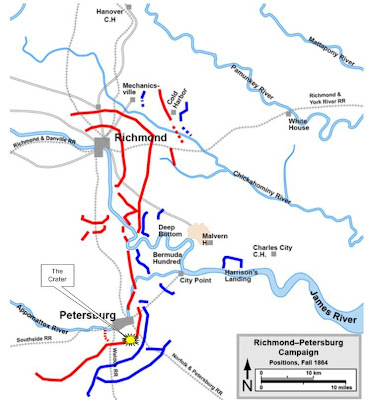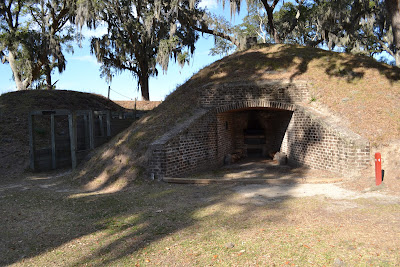On April 3rd, 1865 less than a week before his surrender Lee and The Army of North Virginia left Richmond and Petersburg. His objective was to move south and join up with remnants of General Joe Johnson's Army of Tennessee then fighting to North Carolina. However with Grant blocking him to the south and east, Lee could only move west. The battle map below shows the movement of Lee's columns towards Appomattox Court House.
 |
| Th Retreat to Appomattox Court House |
Lee was harassed by Grant along the entire route in a series of skirmishes. The most serious of which was at Sailor's (or Saylor's) Creek on Apr 6th where the Confederate Army really became unraveled.losing approximately 7700 soldiers and 8 generals captured including Lee's own son. Lee's army staggered on in the hope of reaching Appomattox Station (Now the town of Appomattox and not to be confused with the village Appomattox Court House) hoping to reach supplies that were waiting for him. Unbeknownst to Lee was the fact that Union cavalry troops under General Custer had already arrived at Appomattox Station and had destroyed the supplies (Apr 8th). At the same time Grant sent a note to Lee offering him generous terms of surrender. On the morning of April 9th, Lee tried one more push with his cavalry to reach Appomattox Station but as his troops crested a rise just south of Appomattox Court House they were confronted by the entire Union V Corp. Surrounded on three sides, Lee realized that further resistance was futile and sent word to Grant that he would meet him in the little village of Appomattox Court House.
 |
| Namozine Church |
When I was at the National Park Service (NPS) visitor's center at Five Forks the ranger told me that unlike the other NPS locations, Appomattox Court House closed at 5pm so I needed to be there by 4pm in order to see anything. Since it was already 1:00pm my trip to Appomattox Court House would have to be quick but I thought I would have enough time to follow the trail. I picked up the trail at Sutherland Station on the Namozine trail. The first stop was the Namozine Church were Union and Confederate Guard forces clashed
 |
| Add caption |
After the church I continued to follow the Namozine trail. The country side was beautiful but the road got smaller and smaller and smaller until I was on a little dirt road going over a wooden bridge. There was no where to run around. The thought of being stuck in the backwoods of Virginia was not a pleasant thought. I finally came to an intersection and started pouring over the state and NPS maps which were no help. I pulled out Lucy (the GPS) and told her I wanted to go Amelia Court House which I thought was nearby. This time Lucy gave me instructions but again I was on a twisty small roads with no intersections and no signs. Miraculously I arrived at the town. Lucy came through!! From there I told her I wanted to go to Appomattox Court House. She put me on a major road and I was on my way. As we moved along we passed the entrance to Saylor's Creek Battlefield. I stopped in for a quick look. The site looks out over large open fields. I didn't have time to do anything but look at the artifacts at the center and be on my way. I would like to go back someday.
Appomattox Court House
 |
| Appomattox Court House. The courthouse is the building in the Center |
Appomattox Court House was a small village that was established as a way station between Richmond / Petersburg and Lynchburg. It had taverns and hotels for travelers. It was later declared to be the Appomattox county seat. As the county seat it had a courthouse built. The building is referred to as Appomattox Courthouse. Note that "Courthouse" is one word to distinguish it from the town name which is two words. While Lee and Grant met in the town of Appomattox Court House the meeting did not take place in the Courthouse.
 |
| Mclean House |
The meeting took place at the home of Wilmer Mclean. In 1861 Wilbur Mclean had the unfortunate luck of living in on the site of the first battle of Bull Run. To protect himself, he and his family moved to Appomattox Court House.
Lee had suggested to Grant that they meet in the village to which Grant agreed. Col Gorden on Lee's staff approach Mclean and requested the house for the meeting. Mclean agreed. Details of the meeting have been well documented elsewhere so I won't repeat them here.
I have included pictures of the parlor room which has been restored, as
closely as possible, to how it appeared on April 9th 1865. After the
meeting much of the furniture in the parlor was looted by souvenir
hunting Union officers. Most pieces have been recovered and are in
museums around the country. All of the furniture in the room are
reproductions. The brown desk is where Sherman transcribed the terms of the surrender.
The desk to the left is where Lee sat.
"The silent witness". The little doll on the mantle was a toy inadvertently left by one of the Mclean's girls. Like the other items it was taken as a souvenir however the original was returned to the NPS. The doll on the mantel is a reproduction. The original is in the visitors center (the courthouse) in a climate controlled environment.
The road outside of the Mclean house leading to Appomattox Station. To the left is the crest of the hill where the last clash between Lee's and Grants soldiers took place. Beyond the crest stood the Union V Corp. Along this road is where the remnants of Lee's army were paraded, laid down their arms and were paroled. It was also the site where the Union Troops under General Joshua Chamberlain paid a final salute of arms to their defeated foes. A gesture reciprocated by the Confederates.
The surrender at Appomattox did not represent the surrender of all Confederate forces. However it was the signal for the other Confederate forces to follow suite. Joe Johnson's army of Tennessee, the largest surrender, took place on April 26th in North Carolina.. Other forces continued to surrender throughout May and June of 1865. The last surrender was the privateer CSS Shenandoah in Nov 1865.
After the war the town of Appomattox Court House faded away to oblivion. The village was dying before the war because the railroad. which had supplanted stage coaches, had been located a number of miles away in the new town of Appomattox Station. After the war Virginians really didn't want anything to do with the town because of what happened there. The town was abandoned until taken over by the NPS and restored to its current state in 1947.
The Mclean's abandoned the house in 1867. For a few years it was rented by the bank. The house was then purchased by some entrepreneurs with the idea of moving it to either Chicago for the 1893 worlds fair or to Washington as a tourist attraction. They got so far as to document and dis-assemble the house. Then the plan died and the pieces laid exposed to the elements. In the mid 1940's the NPS, using the plans and some of the original pieces reconstructed the house to its present state today




















































